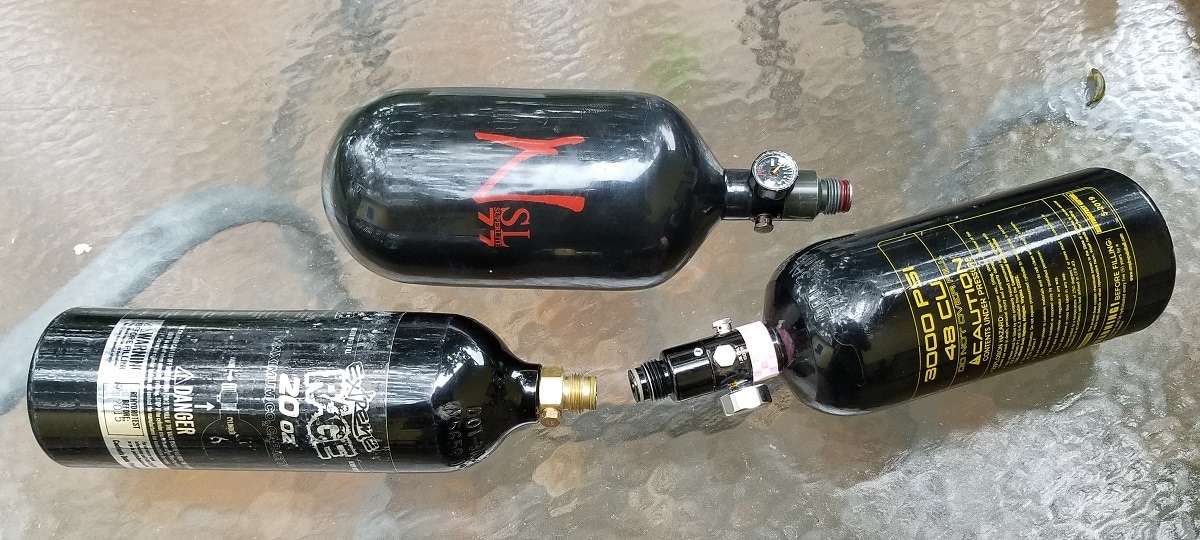The Two main air sources in paintball are CO2 and Compressed Air (HPA), with HPA being the most widely used today. They are completely different gasses and not all paintball guns are compatible with both air sources.
Table of Contents
What is The Difference Between CO2 and HPA Paintball Tanks?
The primary difference between CO2 and HPA Tanks are that CO2 Tanks are filled with Carbon Dioxide and HPA Tanks are filled with compressed air that we breathe, similar to a scuba tank. HPA Tanks are much more stable and have a regulator built in for a consistent output pressure, but CO2 is an unstable gas that can change pressure depending on the temperature.
Do Paintball Guns use CO2 or Compressed Air?
All Paintball guns need an air source to operate, but not all guns can use both CO2 and HPA. All paintball guns on the market right now can use compressed air, but only the basic paintball guns like Tippmanns, Spyders, and pistols can use both CO2 and compressed air.
Paintball guns made by Dye, Planet Eclipse, Empire, GOG, Bob Long/Field One, Proto, SP, and Luxe require the use of compressed air tanks and can not run on CO2. If you use CO2 on any of the above you run a very high risk of damaging your paintball gun.
If you are uncertain as to what air source your paintball gun uses, your owners manual will specify what air source to use.
What Are CO2 Paintball Tanks?

As stated above, CO2 tanks are filled with carbon dioxide and is stored as a liquid within the tank. When the liquid exits the tank into your paintball gun the ambient heat in and around the gun will convert the liquid CO2 into a gas and allowing your paintball gun to shoot a ball.
CO2 tanks are a much more simple design compared to that of an HPA tank as they don’t have a regulator. These tanks are designed to hold a constant pressure of 850-900 psi and should not exceed 1000 psi.
– How Many Shots Can You Get From a CO2 Tank?
Most paintball guns will get about 50 shots per ounce of CO2 in ideal weather conditions. This can change in colder weather, reducing how many shots you will get per ounce.
– How Much Does it Cost to Fill a CO2 tank?
When I worked at a sporting goods store, we charged between $4 to $6 to refill CO2 tanks between 9 oz to 24 oz. This is the same at most hardware and gas suppliers throughout the United States.
– Do CO2 Tanks Come Filled?
CO2 tanks that are designed for paintball do not normally come filled from the manufacture. There are one time use tanks like 90 gram tank and 12 gram cartage come filled and ready to use with the correct adapter.
– Pros and Cons Of CO2 for Paintball
Even though it is considered old and obsolete, CO2 is still a viable source of air for starter paintball guns. Still, there are some limitations to using CO2 long term.
Pros
- Cheaper Tanks – CO2 tanks are much cheaper than HPA tanks and average in price between $18-$30.
- More Shots Per Fill – CO2 is a denser gas than compressed air, allowing more shots per fill compared to a similar sized HPA tank.
- Easier to get filled – If you don’t have a paintball field or pro shop near buy, you can still find plenty of places to fill a CO2 tank by typing in “CO2” and your location in google.
- Older paintball guns work better with CO2 – Back when paintball was starting out most of the guns were designed to run on CO2, some even on liquid CO2.
Cons
- Freezing – As CO2 expands from a liquid to gas it chills the tank and the gun. The more you shoot, the colder everything gets. This can cause your gun to jam up and stop working, especially in cold weather.
- Unstable pressure – When the tank temperature drops, so will the output pressure. This will cause your velocity to drop off until you let everything warm back up. The opposite is also true for hot temperatures as well where the tank may over-pressurize, causing your velocity to spike or cause a burst disk to blow it gets too hot.
- CO2 cloud will obscure vision – When you shoot a paintball gun powered by CO2 you will get a white cloud at the end of your barrel. This can obscure your vision or even give away your position.
- Liquid CO2 is hard on the gun – The combination of temperature and pressure fluctuation can be hard on some of the seals and especially so on the solenoids on electropneumatic paintball guns.
- You can’t “top off” your tank – There is no easy way to just add CO2 to your tank. In order to fill it, you must dump all the CO2 in the tank to chill it and then fill it back up.
- Paintball gun compatibility – Most paintball guns on the market today are not compatible with CO2. Only the most basic guns will work with both CO2 and HPA.
- Some fields are phasing CO2 out – There are many fields that no longer have the equipment to fill CO2 tanks and stopped supporting the use of them on their field.
What Are HPA Paintball Tanks?

Compressed air tanks, commonly called High Pressure Air (HPA), Nitrogen, Nitro, or N2 Tanks, are filled with compressed breathable air similar to a scuba tank. They hold between 3000 psi and 4500 psi and are made of aluminum or carbon wrapped aluminum.
The pressure that paintball tanks hold is not the output pressure but how much pressure the tanks can hold. HPA tanks have a regulator built into the valve that will lower the tank pressure to a usable output pressure for your paintball gun. The standard HPA Tank output pressure is 850 psi, but some can be adjusted from 300 psi to 1100 psi depending on the regulator installed.
HPA tanks were originally used to counteract the major drawbacks that CO2 had on paintball guns by introducing a more consistent air source that isn’t affected by temperature. You can shoot your gun as fast as you want and you won’t have shootdown like you would with CO2.
– How Many Shots Are In an HPA Paintball Tank?
Shots per fill will differ between 3000 psi tanks and 4500 psi tanks based on their size, measured in cubic inches (ci). You can expect about 10 shots per ci from a 3000 psi tank and about 15 shots per ci from a 4500 psi tank with most paintball guns. More efficient paintball guns like the Bob Long G6R, can get even more shots per fill than your standard paintball gun.
– How Much Does It Cost To Refill an HPA Paintball Tank?
Most fields have unlimited refills for the entire day of play for $5 to $10 and some proshops charge $1 per 1000 psi. Filling an HPA tank is significantly cheaper to refill when compared to CO2.
– Pros and Cons of HPA Paintball Tanks
HPA is considered to be the superior air source for paintball guns when compared to CO2. With their immunity to temperature changes and the ease of refilling the tanks on the field, HPA tanks are the obvious choice for just about any paintball player.
Even with that being said, they are not without their own faults. There are a handful of occasions where CO2 would be the better choice, but those are far and few in between.
Pros
- Consistent Pressure – Output pressure is not effected by the temperature outside.
- No cloud obscuring your vision – Compressed air is just is much less likely to obscure your vision when shooting. Unless it is extremely humid out, you won’t see any cloud of gas in front of you when shooting.
- Safe to use on all paintball guns – All modern paintball guns on the market are designed to be used with compressed air.
- Most fields have unlimited refills – Every field I have gone to charge a flat fee of $5 to $10 to refill the tank the entire day.
- Easy to refill and top off – HPA tanks can be refilled and topped off easily by attaching the fill hose to the fill nipple and fill. No need to dump the air in the tank to refill.
- Can be easily refilled with a scuba tank – If you play paintball on your ow property or do tech work and have a scuba tank, you can easily fill your tank without having to go to a pro shop or paintball field.
- Adjustable output pressure – Tank regulators from companies like Ninja Paintball can be adjusted to as high or as low of an output pressure as you need for your paintball gun.
Cons
- HPA tanks are expensive – When compared to CO2 tanks, HPA tanks are considerably more expensive. They can range between $40 and $250 depending on what material the tank is made out of and what kind of regulator is installed.
- Need specialized equipment to refill – If you need to refill your tank, you will need to either find a pro shop, paintball field, or use a scuba tank with an adapter.
- HPA tanks are bulky – When compared to that of a CO2 tank, HPA tanks are significantly more bulky when comparing shots per tank.
- More complicated valves – HPA tank valves are not just a simple open and close pin valve but a regulator with a pressure gauge and air inlet to refill the tank.
Different Types of Paintball Tanks
The two main paintball tank air sources are CO2 and Compressed Air, and those tanks are made differently from each other. There are also a couple different types of compressed air tanks to choose from as well.
Aluminum HPA Paintball Tanks
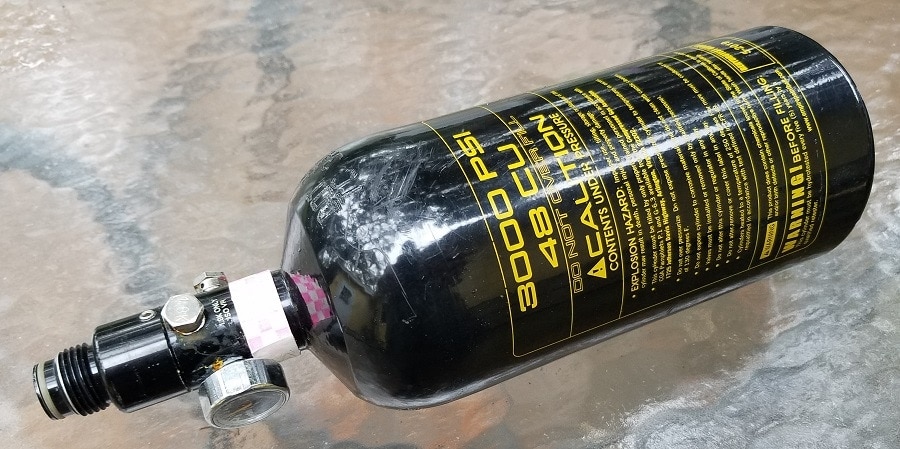
The basic HPA paintball tanks currently available on the market today are made of aluminum and are rated to a maximum fill pressure of 3000 psi. These are your more affordable HPA tanks that players normally start out with.
The different tank sizes you will see are 9 ci, 10 ci, 13 ci, 17 ci, 22ci, 26 ci, 45 ci, 48 ci, 62 ci, and 68 ci. They also come in different shapes as well, the 9 – 22 ci tanks are normally available in 2″ diameter tanks for tank in stock setups and are exempt from hydrotesting.
Pros:
- More affordable – When compared to their fiber wrapped counterparts, the aluminum HPA tanks are much more affordable. Aluminum HPA tanks usually cost between $40 and $60.
- Small tank sizes available – If you need a really small tank for magfed or pump paintball, you can get them as small as 9 cubic inches.
- Unlimited lifespan – DOT stamped aluminum HPA tanks do not have an expiration date, so they can be continuously hydrotested every 5 years until they fail the test.
Cons:
- Larger tanks can be heavy – The 48 ci and 68 ci aluminum tanks are noticeably heavier than their fiber wrapped counterpart. This can offset the balance of your paintball setup.
- Limited to 3000 psi – Aluminum tanks are rated to safely hold 3000 psi and can’t be modified to safely hold more pressure.
- Basic tank regulators are limited in what they can do – The cheaper aluminum tanks come with the bare basic non adjustable regulator with an output pressure of 850 psi.
Fiber Wrapped HPA Paintball Tanks
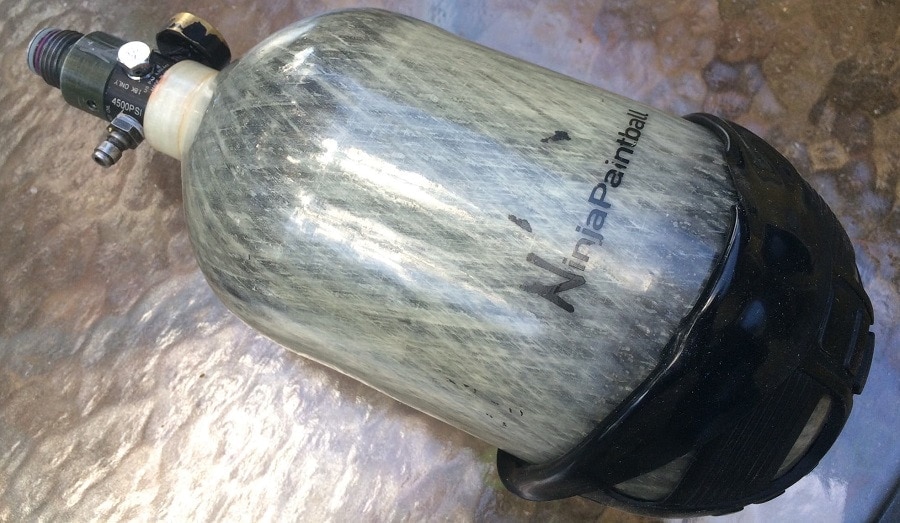
The higher end paintball tanks are typically fiber wrapped tanks with aluminum cores and are rated to a maximum fill pressure of 4500 psi. These tanks are much lighter than your typical aluminum tank, come with better regulators, and will give more shots per fill.
Fiber wrapped tanks don’t come in as many different sizes as the aluminum tanks but there are still plenty to choose from. Common sizes are 45 ci, 50 ci, 68 ci, 77 ci, and 90 ci. Some companies are starting to develop smaller, more compact fiber wrapped tanks between 13 – 26 ci as well.
Pros:
- Light weight – The most noticeable difference when comparing aluminum tanks to fiber wrapped tanks is the weight difference. Modern fiber wrapped tanks are getting lighter and lighter as the technology improves and are much lighter than the tanks from 10 years ago.
- Hold more air – Fiber wrapped tanks hold 50% more pressure than the standard aluminum tanks giving a higher shot per fill count.
- Adjustable output pressure – As these tanks are usually more expensive, some manufactures like Ninja Paintball make their regulators adjustable by adding or removing shims in the regulator.
- Higher Quality Construction – These tanks come with much better regulators than what comes on the aluminum versions. They are easy to maintain and rebuild if necessary.
Cons:
- Expensive – The biggest downside to fiber wrapped HPA tanks is the initial purchase price. Fiber wrapped tanks will run between $120 and $250 depending on the regulator, size and process used to manufacture the tank.
- 15 year lifespan (DOT tanks) – Most fiber wrapped compressed air tanks on the market have a usable lifespan of 15 years before it has to be retired. The UN/ISO stamped tanks have “lifetime” service life (their documentation states 38 years). Both tanks need to be hydrotested every 5 years.
- Higher potential for damage – As the outside of the tank isn’t solid metal, the gel coating and fiber wrappings can sustain damage if hit to hard. This is reduced or eliminated by using a tank cover.
– Knockoff HPA Tanks
A word of caution when buying unbranded HPA tanks. There is plenty of temptation to buy cheaper off brand compressed air tanks, but I would avoid buying them.
These off brand tanks themselves may qualify to hold the DOT or ISO approval stamp, but they may not be suited for the abuse of paintball. Also, one of the key parts of the tank is the regulator itself. It has to make sure the tank is constantly supplying the desired output pressure at all times. A cheap, not well made regulator may vary in output pressure or cant be rebuilt if the seals are worn out. Stick with the known paintball tank manufactures for safety and less headaches down the line.
CO2 Paintball Tanks
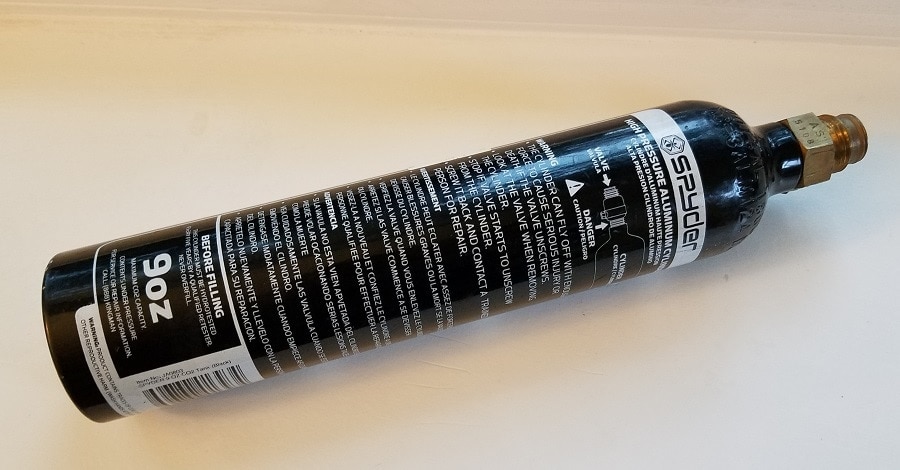
CO2 paintball tanks are typically made out of aluminum and have a super basic pin valve to let the gas in and out. CO2 tanks normal operating temperature is between 800 psi to 900 psi and the internal tank pressure can change due to temperature around the tank.
These tanks store CO2 as a liquid inside of the tank and the tank sizes are measured in ounces (oz). Typical CO2 tank sizes are 9 oz, 12 oz, 16 oz, 20 oz, and 24 oz.
– Do Not Fill a CO2 Tank With Compressed Air.
I commonly see people asking “can I fill my CO2 tank with compressed air?” or “can I convert my CO2 tank to an HPA tank?” The answer is no, do not for any reason attempt to fill your CO2 tank with compressed air. These tanks are not designed or rated to withstand the pressures usually seen with HPA tanks.
CO2 tanks are designed to hold and contain liquid CO2 that won’t usually exceed 1000 psi, HPA tanks are designed to hold at least 3000 psi. As you can see, there is a massive pressure difference between CO2 and HPA tanks. Not only that, the process of attempting to convert your CO2 tank to HPA will cost you nearly as much money as buying a new 48/3000 HPA tank. It’s not worth it, can be quite dangerous, and won’t achieve the results you are expecting.
One Time Use Disposable Tanks and Non-Refillable Paintball Tanks
Lots of starter paintball kits come with disposable CO2 canisters that are designed for one time use. Some of them like the 90 gram CO2 cartridges come with a pin valve that will screw into your standard tank Air Source Adapters (ASA) on your paintball gun. Others like 12 gram CO2 cartridges will need an adapter or have the 12 gram pierce pins built into the paintball gun itself.
These 12 gram and 90 gram CO2 cartridges are not refillable. They are intended to be disposed of after being used.
How to Choose The Right Size Paintball Tank
Because paintball tanks come in a variety of sizes, you will have to think about how you are attaching your tank to your paintball gun, how long you want it to be, and how many shots per fill you will need.
One of the key factors that some people overlook when buying a new tank is how long the tank is itself. If it is too short, it may be uncomfortable tho hold and the back of your paintball gun will be right up in your face. If it is too long, the setup will be unwieldy and hard to aim when tucked in tight to a bunker.
I personally have found that 68 ci fiber wrapped tanks, 77 ci super light fiber wrapped tanks, 48 ci aluminum tanks, and 20 oz CO2 tanks to be the most comfortable size for most players including myself.
If you need more shots per fill, then the larger the tank the better. This Ninja 90/4500 HPA tank on Amazon will average 1350 shots per fil on most paintball guns and can get up to the 1700+ range on the more efficient paintball guns.
If you are going to run a remote line, or hose, from your paintball gun to a tank held in a pouch, your only real limitation is the size of your pouch and how difficult will it be to carry.
High Pressure VS Low Pressure HPA Tank
The standard output pressure for paintball tanks is 850 psi, but some paintball guns require a low output tank pressure so the guns regulator isn’t getting overworked. To solve this, companies like Ninja and First Strike have tank regulators that are designed to have a lower output pressure.
If you don’t know what input pressure your paintball gun needs, check your owners manual. If it needs a lower pressure, it will tell you exactly what pressure your tank needs to supply for optimal results. If it doesn’t say, it is safe to assume that you can use the standard output tanks with 850 psi like most every paintball gun on the market.
How to Fill Your Paintball Tank
Making sure your tank is filled before each game is necessary for a successful round. The last thing you need is to run out of air in the middle of a game!
How to Fill Your HPA Tank
The best (and sometimes only) places to get your HPA tank filled will most likely be a paintball field or pro-shop. You might be able to find a scuba shop with the right setup, but you will have to ask around first.
Filling your HPA tank is pretty easy to do, the only thing you will want to check before filling your tank is to see if your tank is rated to 3000 psi or 4500 psi. Most paintball fields I go to have two separate fill stations, one for 3000 psi tanks and one for 4500 psi tanks.
Do not fill your 3000 psi tank with the 4500 psi fill station, even if you are watching it. Pressure gauges are an estimate and can fluctuate or be delayed as air is rushing past them. The only way to know if you are not overfilling your tank and blowing burst disks is by using the correct fill station.
– Filling Your HPA Tank in 3 Steps:
- Attach the fill hose to the tank – locate the fill nipple and hose from the fill station. Then pull the locking ring back on the hose and slide the fitting over the fill nipple. Press the hose fitting all the way on to the fill nipple and make sure the locking rings return to the forward position
- Press the fill button or fill lever – With the hose attached securely (give it a tug first to see) activate the fill station and start pumping air into your tank! Your fill station will automatically stop at its max fill pressure, so keep filling until it stops. When it stops, just release the button or lever.
- Remove the hose and hit the field – Pull back the locking rings on the hose fitting, pull off the fitting and you are done!
– Filling Your HPA Tank With a Scuba Tank

If you have a scuba tank with a standard K valve, you can use a fill station adapter to fill your paintball tank just like a fill station at the paintball field.
Here is a great video showing you how to use the fill adapter from Elite Paintball:
– Filling Your HPA Tank With a Hand Pump
No you can’t use a standard bike pump to fill a paintball tank, but you can use a high pressure Stirrup Pump to fill a tank. This will not be an easy task to do and will take you a few hours to fill a tank. The last example I saw took someone 3 hours to fill a 42/3000 tank and had to pump over 750 times.
If you want to go this rout you will want to use the 4 stage pump so you don’t wear yourself out quickly using a 3 stage. The 4 stage will have less resistance and allow you to pump faster for longer. Also, you will want a water separator or desiccant kit to remove any moisture from getting into the tank and causing corrosion. Here is a good example of one on Amazon: https://amzn.to/2O59jxy
– Can you put CO2 In A Compressed Air Tank?
It is not advisable to fill an HPA tank with CO2 or any other gas that it was not originally designed to hold. Not only that, the regulators on HPA tanks are not designed to be used with CO2 and will most likely fail due to the sudden temperature change.
– Can You Fill a Paintball Tank With an Air Compressor?
Most air compressors for general use only get up to 90 psi, so filling your paintball tank with a general purpose light to medium duty air compressor will not work. They simply do not provide enough pressure to fill or even top off your tank.
How to Fill Your CO2 Tank
Filling a CO2 tank isn’t as easy as an HPA tank, but it is still relatively easy to do. I use to fill up CO2 tanks every day when I worked at a sporting goods store and became very proficient at doing them.
– How to Fill Your CO2 Tank
To fill your CO2 Tank, you will need the following equipment:
- CO2 Fill Station – You will need a proper CO2 Tank fill station that allows you to both fill and dump the air out of the tank you are filling. Make sure to get a decent one as CO2 can be hard on the plastic seals. This one From Maddog Paintball on Amazon should get you rolling – https://amzn.to/353cnkW
- CO2 Tank with siphon – You will need a tank to fill liquid CO2 from and will need a tank with a siphon to transfer liquid CO2 to your tank that you are filling. These tanks can be picked up or rented out from your local CO2 supplier. The best way to find them is by googling “CO2 supplier near me.”
- A scale to weigh the tank – Liquid CO2 is measured in ounces and you will need a scale to see how full your tank is when filling. A digital scale like this one on Amazon will do exactly what you need – https://amzn.to/2Qm7nU7
- Protective gloves – You MUST protect your hands when filling your CO2 tank. In order to fill your tank properly you will be dropping its temperature to the point that it will freeze over. To make sure the tank doesn’t slip out of my hands, I prefer the gloves with a non-slip palm on them like these on Amazon – https://amzn.to/2qUSiyc
- Safety glasses – Don’t discount the necessity of wearing safety glasses when filling these tanks. More than once have I had a tank’s burst disk blow from the rapid temperature change and send small bits of metal towards my face.
Step 1: Chill Your CO2 Tank
In order to fill your tank, you will first need to chill the tank to allow the liquid CO2 to enter the tank and remain a liquid. As heat causes liquid CO2 to transition to a gas state, not chilling the tank won’t allow you to fill it anywhere near full.
With your gloves and safety glasses on, make sure your fill station is attached and all valves turned to the “off” position. Screw in your CO2 tank that you will be filling on the hose adapter and screw in the on/off screw on the top of the adapter to open up the CO2 pin valve. If there was anything in the tank, this will pressurize the hose.
With the tank secured, dump whatever CO2 is in your tank with the fill stations dump lever. If there was enough CO2 in the paintball tank, the tank should become frosty and ice cold.
If there was no air in the tank or not enough to chill the tank, you will need to dump some CO2 into it and then dump it out to chill it. With the dump level turned back off, open up the fill lever until the tank no longer fills up (it shouldn’t take long, maybe 5 to 10 seconds). Then close the fill lever and open up the dump lever to expel the gas and chill the tank.
When done properly, the tank will look frosted over and very cold to the touch. And to answer the question that will pop into everyone head, yes your tongue will stick to a chilled CO2 tank. Take my advice from personal experience, don’t do it. It isn’t as fun as it sounds.
Step 2: Fill and Weigh Your Tank
With your tank chilled and empty, close the dump lever and place your tank on the scale. I like to use the hanging fish scales and loop the hook where the hose and the fill adapter you screwed your CO2 tank into meet. Make sure to zero out the gauge after you attach the tank for a more accurate reading.
From here you want to start filling your tank with liquid CO2 by opening up the fill lever and watch how much you are putting in the tank. I like to fill just below the maximum fill weight to account for temperature fluctuation the the tank won’t over pressurize. For example, when filling a 20 oz CO2 tank, I will fill it to 19 oz to 19.5 oz so when the tank is brought out to the Florida heat, it won’t rupture the burst disks.
Step 3: Purge The Line and Remove The Tank
Now with both the fill and dump levers turned off, unscrew the on/off on the tank adapter to close the pin valve on your CO2 tank. Some tank adapters will automatically purge the line when doing this, but if it doesn’t open the dump valve to remove the excess air.
Now you can remove the tank from the hose and attach it to your paintball gun.
– Can You Fill a CO2 Tank With Compressed Air?
No, CO2 and Compressed Air tanks are designed to hold two different pressures and hold two different gasses. CO2 tanks should not be filled with anything other than CO2.
– Can You Convert a CO2 Tank to HPA?
No, not only is this highly dangerous but it will be a waist of money as no paintball field will allow you to use it. You can purchase a 48/3000 HPA tank for only $40, so there is absolutely no reason to even attempt to convert a CO2 tank to HPA.
What You Need to Know About Hydrotesting Your Paintball Tank

So what exactly does it mean to perform a hydrostatic test on a paintball tank? Hydrostatic tests, sometimes called hydro test and just simply hydro, is a required re-certification for all refillable CO2 and HPA paintball tanks. These tanks are required to be hydro tested every 5 years by a certified technician.
How to Read The Hydro Test Date On Your Paintball Tank
If you are unfamiliar with how the original manufacture date is represented on your paintball tank, I have several examples shown below.
CO2 and Aluminum tanks have the original manufacture date stamped into the side of the tank itself. Booth CO2 and HPA tanks need to be hydrotested for the first time 5 years after this date.
DOT Tanks will display this date with month first and then the year. ISO tanks will display the year first and then the month .

Fiber wrapped HPA tanks will have the dates printed on the tank and then covered by a clear gel or epoxy layer. Fiber wrapped HPA tanks need to be hydrotested for the first time 5 years after this date.
The last picture example shown below is on a tank that was sent in for a hydrotest. This tank has another 5 years after this date before it needs to be tested again.
DOT fiber wrapped paintball tanks have a max lifespan of 15 years after they were manufactured before they need to be decommissioned and scrapped. ISO fiber wrapped paintball tanks have a max lifespan of 38 years after they were manufactured before they need to be decommissioned and scrapped.

Places to Hydrotest Your Paintball Tank
Knowing you need a hydrotest on your paintball tank is one thing, but where can you hydrotest your tank?
Ideally you want to have your paintball tank tested by a paintball company as they have the experience and the tools needed to add or remove tank regulators and are familiar with the tanks themselves. You can ship your tanks out to for a hydrotest at the following locations:
https://www.ninjapaintball.com/hydro (DOT tank tests, reg swaps, and epoxy repair)
http://www.hydrotester.com/ (DOT, ISO, CO2 tank tests)
You can also just type in “hydro test tank near me” in google to pull up scuba shops, tank suppliers, and specialized local shops that can test your tank for you. Not all hydrotesters can re-certify all tanks. For example, DOT certified facilities can only test DOT stamped tanks, not ISO stamped tanks.
You will want to remove your tank regulator before sending it to a non paintball facility as they don’t have the proper tools and experience to remove the regulator without damage. I have had a few expensive regulators destroyed because the facility didn’t know what they were doing.
How to Maintain and Repair Your Paintball Tank
Just like any bit of paintball gear, you will have to do maintenance and repairs on your paintball tanks. Thankfully, they are simple and easy to take care of and need very little attention.
Replacing Your Burst Disks

The most common repair you will have to do on any paintball tank is replacing their burst disk when they rupture. They are designed to prevent the system from over pressurizing and causing damage to the unit.
Standard paintball tank burst disks are easy to replace. Remove them with a 3/8 wrench or socket and install the replacement burst disk with the same value in its place. Tighten the new one down to about 5 in-lbs of torque to compress the brass fitting and creating an air seal. If air is coming up around the burst disks threads, tighten a little more until the leak goes away.
If you need a new burst disk, you can find them on Amazon quite easily. Just check the number printed on the side of of the burst disk and replace it with one of the same value.
1800 psi burst disk – https://amzn.to/2CTNgEQ
3000 psi and CO2 tank burst disk – https://amzn.to/2rK9V4e
5000 psi burst disk – https://amzn.to/2qmLeul
7500 psi burst disk – https://amzn.to/351p93k
– How Do You Know if Your Burst Disk Needs to be Replaced?
Burst disks are either working or not working, there is no in between functionality. Once it ruptures there is no going back and it must be replaced.
If air is rushing out of the vent holes with no signs of stopping, then the burst disk has ruptured and needs to be replaced.
– Low Profile Tank Burst Disks

First Strike HPA tanks come with these really cool low profile burst disks that provide a slimmer look. This design requires the user to use a 5/32 hex key to remove and install instead of a socket driver or wrench.
The low profile burst disks have to be picked up from either the tank manufacture or a major paintball store like ANSGear.com.
Low profile burst disks have the same 3/8-24 threads as the standard paintball burst disks.
Rebuilding Your Regulator
Every now and then, you will have to do maintenance on your HPA regulator to make sure the tank output remains consistent. This is super easy to do and the parts can be picked up by the manufacture or any major paintball retailer.
The best way to know if your HPA tank regulator needs to be repaired or rebuilt is if the 1.8k burst disk ruptures. This burst disk will only blow if the tank output pressure starts to fluctuate wildly, over pressurizes, or has reg creep.
Before you rebuild your tank regulator, you must completely depressurize the tank. This can be done by depressing the pin valve until all the air has escaped and remove the bonnet. Your rebuild kit will have instructions on how to open up the regulator and what to replace.
Protecting Your Paintball Tank
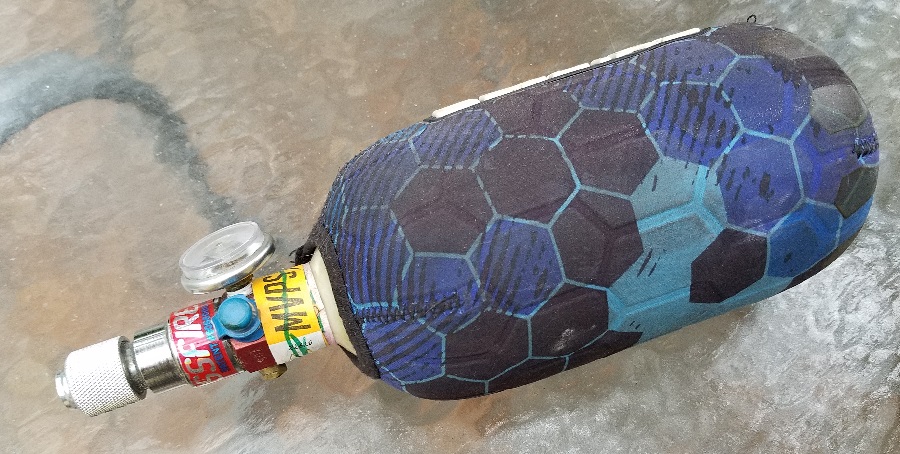
Our paintball tanks can be one of the most expensive pieces of equipment in our gearbags, but some of us don’t protect the threads or the the tank itself.
Protecting the threads and regulator face from drops and poor storage is one of the best ways to ensure the longevity of your tank. If the threads are damaged or the tip smashed in, it wont seal properly or even insert into your ASA. This is easily to do and quite cheap! Just use a thread protector like this one on Amazon to put over your tank threads to make sure they don’t get damaged when not in use: https://amzn.to/2Ofbv5G
When you are on the field, your tank may get banged up against bunkers or the ground and get scuffed and scraped. They can also get dinged up in your gearbag or dropped on the ground. The best way to protect the tank itself is with a tank cover, they will protect the surface from impact and scratches.
Who Makes The Best HPA Paintball Tanks?
Over the years I have used a bunch of different paintball tanks from all of the major paintball tank manufactures. When choosing my next tank, I consider the price of the tank, size of the tank, regulator reliability, and then any extra features like weight and construction. These considerations will change depending on how they are going to be used.
My two favorite companies that make paintball tanks as of today are Ninja Paintball and First Strike Paintball. They both have excellent quality regulators and tank build quality while offering various tank output pressures for their higher end tanks.
Aluminum Paintball Tanks

If you want to pick up a 48/3000 tank, Ninja Paintball tank will be the best build quality available today. You can find them on Amazon for a great price: https://amzn.to/2qqjBk2
Otherwise, Tippmann’s 48/3000 tank will get the job done for any player and can be found for a bit cheaper. Check Amazon for current prices: https://amzn.to/3a0u4Es
Best Fiber Wrapped Paintball Tanks
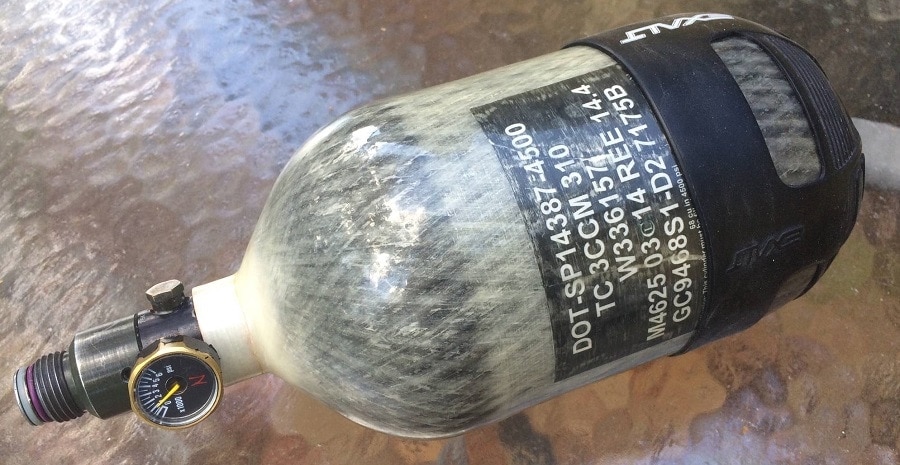
If you want to pick up your first fiber wrapped tank, I would start off with the Ninja 68/4500 tanks. They come with excellent regulators that have adjustable output pressures and come in several cool colors! These tanks are absolute workhorses and are excellent tanks for the money. You can pick one up on Amazon here: https://amzn.to/35d7wO5

If you want a step up the tank quality, you can pick up one of the First Strike Hero 68/4500 tanks. They are about 30% lighter than your standard fiber wrapped HPA tanks and come with really nice and sleek low profile burst disks and small tank gauges. They also have a 38 year lifespan compared to the 15 year lifespan of the other DOT stamped tanks. You can pick one up on Amazon here: https://amzn.to/2Kvo5Ng
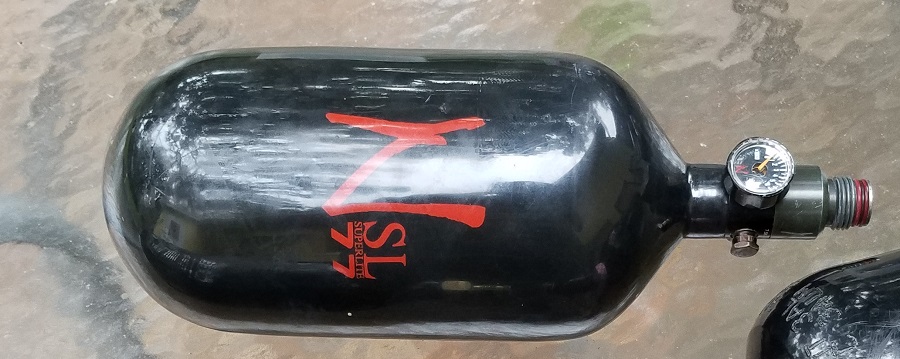
My absolute favorite tanks on the market are the Ninja 77/4500 tanks. They are ridiculously light, smaller profile when compared to similar sized tanks, and come with the V2 Ninja regulators. My wife uses the 68/4500 version and likes that it holds more air than her standard 45/4500 tank and is almost the same size (I can use the same tank cover).
You can pick up yours on Amazon here: https://amzn.to/2Kxronf
If you want the 68/4500, you can find one here: https://amzn.to/32STRKA

